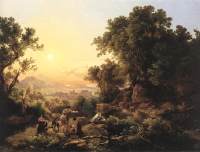
Three planes of landscapes, the classical principle of art academies is characteristic of almost all pictures of Markó. It is present in the composition Diana Hunting from Markó's period in Rome but in a more intimate way than in any other pictures. The shady foreground is present only a symbolic way and leads to the middle on both sides. Darker masses on the right and left surround sights in the middle and in the background. Looks and gestures of nymphs and stag hounds around Diana, the Roman Goddess of hunting who is drawing a bow, focus on the deer on the right. Dynamic movements on the side do not ruin the balance of the composition: the nymph blowing a horn on the left closes the composition. The group on the left is counterbalanced by the rich foliage of trees on the right, as if a genre picture. Markó, who was aware of the perspective of air, portrayed picturesque motifs of the background lost in the haze with lighter and lighter colours: a typical Italian town in the mountains, the high mountains themselves and the sea bordering the sky. Although he carefully portrayed foliage and leaves, characteristic of his art, he subordinated other details to landscapes uniformly treated and carefully composed. As opposed to German classicist painters in Italy, e.g. J. A. Koch whom Markó knew, heroism, cold distance or hardness is not present in his pictures. Details of nature separately studied produce a perfect composition, a landscape full of romantic emotions.